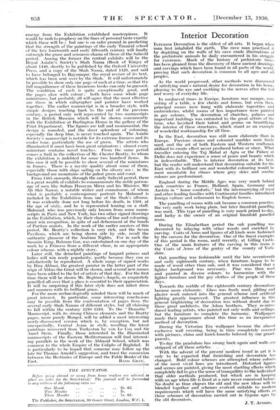Interior Decoration
IrcrEama Decoration is the oldest of all arts. It began when man first inhabited the earth. The cave man practised it by depicting on the walls of his cave crude illustrations of the prehistOric animals he daily encountered in his struggle for existence. . Much of the history of prehistoric times has been gleaned from the discovery of these ancient drawings and carvings which have been found in all parts of the world, proving that such decoration is common to all ages and all peonies.
As the world progressed,- other methods were discovered of satisfying man's natural desire for decoration in his home, pleasing to the eye and soothing to the nerves after the toil and worry of everyday life. - - In mediaeval times in Europe, furniture was meagre, con-
sisting of a table, "a fw ohesul and forms, but even then, principal rooms were hung with elaborate tapestries and embroideries, whilst rooms of less importance were painted in gay colours. The decoration -of churches, palaces and important- buildings was entrusted -to the great artists of the time, who lavished their talent arid genius on beautifying the interior of these structures,- Which stand as an example of wonderful workmanship for mill 'time.
In the East, decoration was still more elaborate than in Europe. Precious stones and coloured marbles were freely used, and the art of both Eastern • and WeStern craftsmen utilized to create effect never produced before or since. What traveller entering the Taj Mahal at Agra or the Palace at Delhi does not experience a sense of peace and beauty which in indescribable. This is interior decoration at its best, but the reader will understand that decoration suitable for the East with its brilliant sun and wonderful colouring would he most unsuitable for climes where grey skies and sombre colours are predominant England during the Middle Ages was very much behind such countries as France, Holland, Spain, Germany and Austria in " home comforts," but the intermarrying of royal and other leading families with Continental families introduced foreign culture and refinement to English homes.
The panelling of rooms with oak became a common practice, the very early work being plain, but later linenfold panelling was used. This type of panelling is very much prized to-day, and lucky is the owner of an original linenfold panelled room.
During the Elizabethan period the oak panelling was decorated by inlaying with other woods and enriched by carving. Coats of Arms and figures of all kinds were fashioned by the carvers for the decoration. One of the finest examples of this period is the room, until recently, at Gilling Castle. One of the main features of the carving in this room is the Coats of Arms of the gentry of the county of York- shire.
Oak panelling was fashionable until the late seventeenth and early eighteenth century, when furniture- began to be made of wood other than oak, and it was considered that a lighter background was necessary. Pine was then used and painted in diverse colours to harmonize with the lighter furniture and the gay clothes of the people of those days.
Towards the middle of the eighteenth century decorations became more elaborate. Glass was freely used, gilding and plaster work entered into the general scheme and artificial lighting greatly improved. The greatest influence in this general brightening of decoration was without doubt due to those great architects, the Adam brothers. They re-intro- duced leading artists, who painted not only walls and ceilings, but the furniture to complete the harmony. Wallpapers made their appearance about this time as an inexpensive method of decoration.
During the Victorian Era wallpaper became the almost exclusive wall- covering, being in turn- completely covered with pictures, china and knick-knacks beloved by our grand- parents.
• To-day the pendulum-has sirung back -again- and walls are
stripped of all these articles. • . - • .
With the advent of the -present modern trend in art it is only to be expected that furnishing and- decoration has changed. Bold colour schemes are attempted where colours of time most vivid hues are introduced. Distorted -figures and scenes are painted, giving the most startling effects which completely-fail to give the sense of tranquillity te the-individual that older methods produced, but which are in keeping with an age when life is lived at a rate never conceived before. No doubt as time elapses the old and the new Ideas will be blended together and schemes evolved suitable to modern requirements which will have the same satisfying effects as those schemes of decoration carried out in bygone ages by the old decorators.
J. T. AVISON.














































 Previous page
Previous page